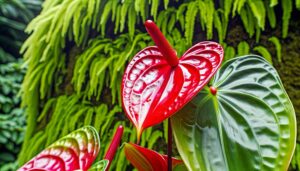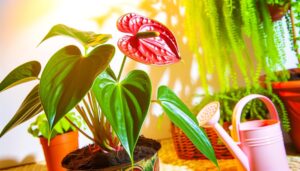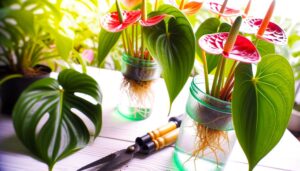Unique Features of the Anthurium Canal Queen: A Guide!
You’ll find the Anthurium Canal Queen remarkable for its lanceolate leaves reaching up to 30 cm, boasting a lustrous adaxial surface and prominent venation pattern. Its vibrant, long-lasting blooms display red, pink, and white spathes that persist for several months due to anthocyanin pigments.
This plant’s velvety, suede-like leaf texture, enhanced by trichomes, reflects light and minimizes water loss. The heart-shaped, glossy spathe not only attracts pollinators but also protects the spadix.
With its diverse hue range from magentas to flaming reds, it adds dynamic color year-round. Discover more about its care, propagation, and air-purifying qualities.

Key Takeaways
- The Anthurium Canal Queen features large, lanceolate, glossy leaves with prominent venation patterns.
- It showcases vibrant red, pink, and white spathes that last several months.
- The plant has a unique velvety leaf texture with trichomes that reduce water loss.
- The heart-shaped spathe is glossy and enhances the plant’s aesthetic value.
- It offers a dynamic display of bright color varieties, including deep magentas and flaming reds.
Large Glossy Leaves
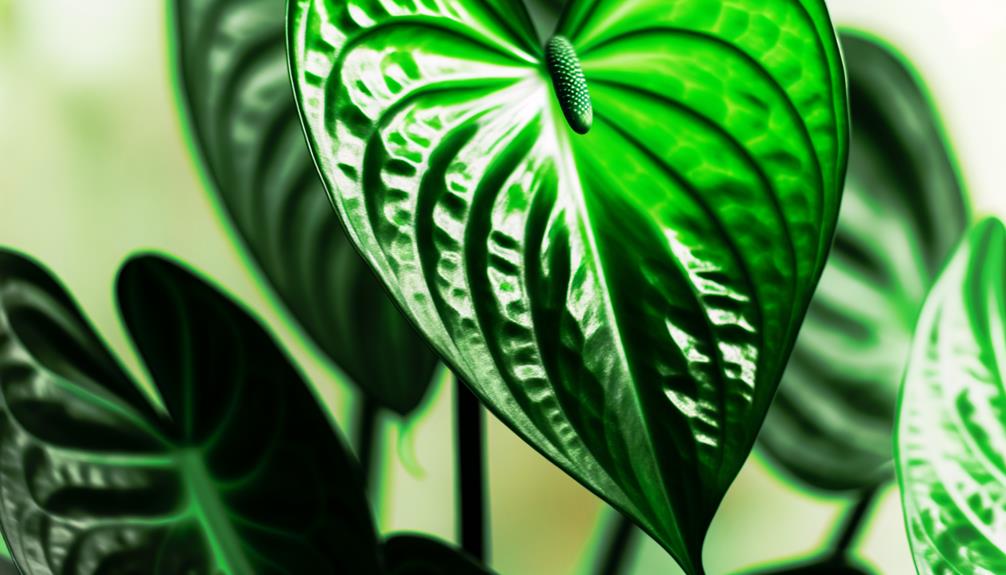
With their large, glossy leaves, Anthurium ‘Canal Queen’ showcases remarkable foliar characteristics that set it apart from other species in the Araceae family.
You’ll notice its leaves are lanceolate, reaching lengths of up to 30 centimeters, and display a rich, green hue with a distinctive sheen.
The adaxial surface is smooth and lustrous, reflecting light in a way that emphasizes its vibrant color. Meanwhile, the abaxial surface is slightly paler, adding a subtle contrast.
The prominent venation pattern, with its clear midrib and pinnate veins, enhances the leaf’s structural integrity.
Vibrant Long-Lasting Blooms
You’ll be captivated by the Anthurium Canal Queen‘s striking color palette, featuring vibrant spathes in shades of red, pink, and white.
These blooms, scientifically known as inflorescences, exhibit an extended bloom duration, often lasting several months.
Additionally, their minimal maintenance needs make them an ideal choice for both novice and experienced horticulturists.
Striking Color Palette
The Anthurium ‘Canal Queen’ frequently captivates with its vibrant, long-lasting blooms that exhibit a striking palette of deep reds and purples, scientifically known as spadices and spathes, which retain their intense coloration for several weeks.
You’ll appreciate the glossy texture of the spathes (modified leaves) that enhances the luminosity and depth of the hues. The spadix, a cylindrical inflorescence, contrasts beautifully, often in shades of yellow or white.
This color combination isn’t just visually appealing but also biologically significant, aiding in pollinator attraction.
The Anthurium’s chromatic brilliance results from anthocyanin pigments, which are stabilized by the plant’s cellular pH. You’ll find these vibrant colors are perfect for adding a touch of exotic elegance to any space.
Extended Bloom Duration
Thanks to its remarkable genetics, the Anthurium ‘Canal Queen’ boasts an extended bloom duration, with its vibrant spathes and spadices maintaining their striking appearance for several weeks, ensuring sustained visual appeal and ecological effectiveness.
You’ll appreciate how these blooms provide not only aesthetic pleasure but also ecological benefits, attracting pollinators over a longer period.
Key features include:
- Longevity of Spathes: The colorful spathes (modified leaves) of Anthurium andraeanum hybrids persist for weeks without fading.
- Sustained Pollinator Attraction: Extended bloom periods enhance interaction with pollinators like bees and butterflies.
- Consistent Visual Appeal: With blooms enduring longer, you’ll enjoy a prolonged display of vivid reds, pinks, or whites that complement various interior designs.
Embrace the freedom of enduring beauty in your space.
Minimal Maintenance Needs
Caring for Anthurium ‘Canal Queen’ requires minimal effort, as its robust nature and vibrant, long-lasting blooms thrive with basic, routine maintenance.
You’ll find Anthurium andraeanum ‘Canal Queen’ prefers a humid environment, so maintain consistent moisture without waterlogging. Utilize well-draining soil rich in organic matter, and uphold a temperature range of 18-28°C. Place it in indirect sunlight to prevent leaf scorch while promoting photosynthesis.
Fertilize monthly with a balanced, water-soluble fertilizer during the growing season. Prune spent blooms and yellowing leaves to encourage new growth.
This minimal care routine allows you to enjoy its striking spathes and lush foliage year-round, providing the freedom to focus on other pursuits without sacrificing botanical beauty.
Unique Leaf Texture
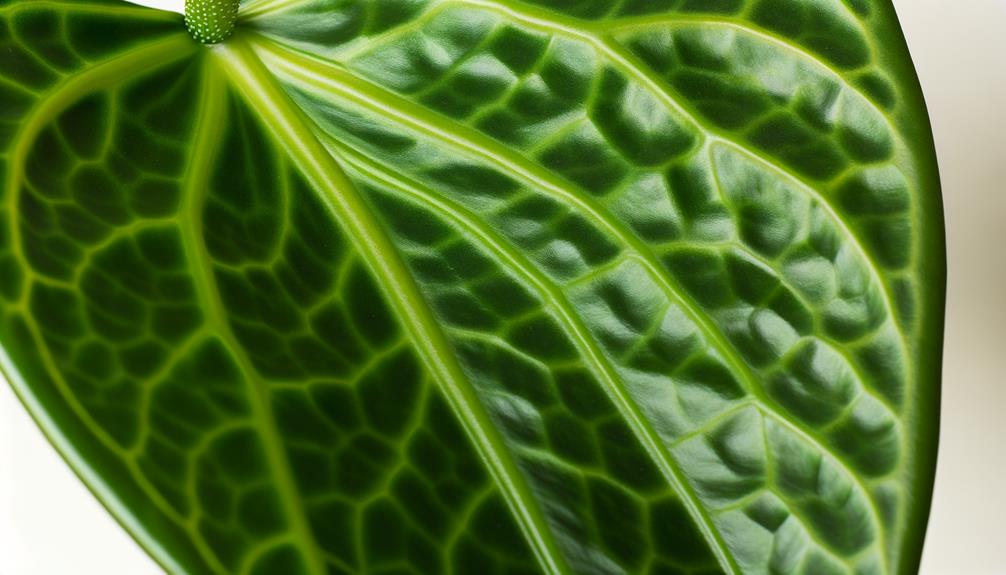
You’ll notice the velvety leaf surface of Anthurium ‘Canal Queen’, which feels almost like a fine suede.
The intricate vein patterns, known as reticulate venation, create a mesmerizing network across the leaves.
These features not only enhance its aesthetic appeal but also play a role in its physiological processes like transpiration.
Velvety Leaf Surface
The velvety texture of the Anthurium Canal Queen’s leaves, known scientifically as Anthurium crystallinum, results from a dense covering of trichomes, which are microscopic hair-like structures.
This unique surface offers several notable benefits:
- Water Retention: Trichomes reduce water loss by trapping moisture, ideal for varying humidity levels.
- Light Reflection: The velvety surface can reflect excess light, protecting the leaf from sun damage.
- Pest Deterrence: Trichomes serve as a physical barrier against herbivorous insects.
You’ll find that these features not only enhance the plant’s visual appeal but also contribute to its resilience in diverse environments.
As an enthusiast, appreciating these subtle yet significant adaptations allows you to value the Anthurium Canal Queen’s botanical ingenuity even more.
Intricate Vein Patterns
Beyond the velvety texture, the Anthurium Canal Queen captivates with its intricate vein patterns, which consist of prominently white, lattice-like veins that contrast strikingly against the dark green leaf surface.
These veins, scientifically known as reticulate venation, enhance the leaf’s structural integrity while aiding in efficient nutrient distribution.
The primary vein (midrib) branches into secondary and tertiary veins, forming a network that resembles a finely woven fabric.
You’ll appreciate how the distinct venation pattern not only adds aesthetic appeal but also plays an essential role in photosynthesis and transpiration processes.
Each leaf of Anthurium andraeanum ‘Canal Queen’ displays this botanical marvel, inviting you to explore its complexity and beauty, offering a deeper connection to the intricate wonders of nature.
Distinctive Flower Spathe
Characterized by its vibrant, heart-shaped bracts, the Anthurium ‘Canal Queen’ boasts a distinctive spathe that’s both aesthetically striking and functionally significant.
This modified leaf, scientifically known as a spathe, surrounds the inflorescence and enhances the plant’s appeal.
You’ll appreciate its unique textures and structural details. Here are three features to note:
- Shape: The spathe’s heart-shaped form (cordate) isn’t just decorative but also serves to attract pollinators.
- Texture: Its surface is typically glossy, which helps in reflecting light and drawing attention.
- Functionality: The spathe protects the spadix (the flower-bearing structure) and aids in the reproductive process by attracting specific pollinators.
Bright Color Varieties
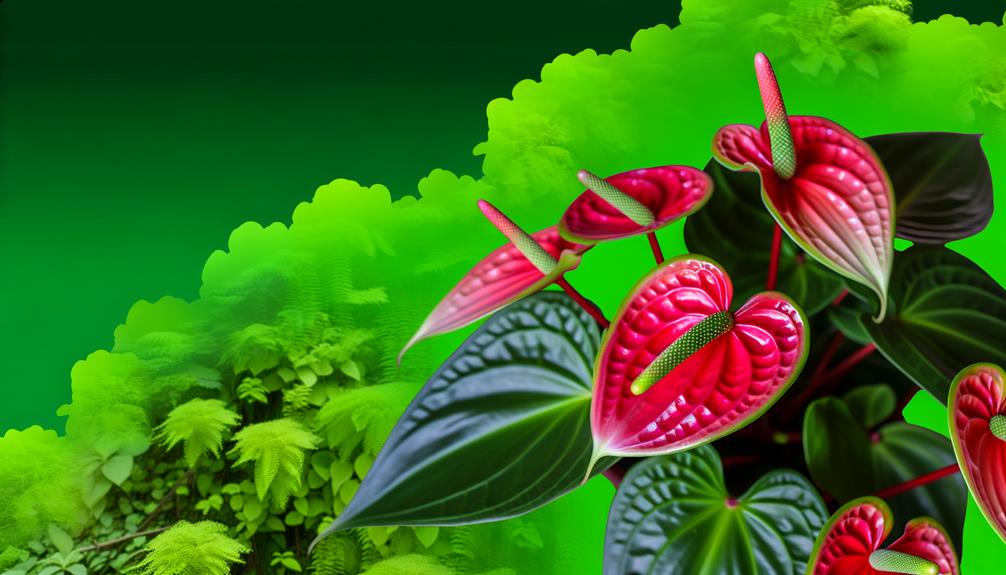
You’ll find the Anthurium Canal Queen showcases a spectrum of vibrant hues, from deep magentas to striking reds. These colors exhibit remarkable durability, attributed to the plant’s high levels of anthocyanins and carotenoids.
Additionally, seasonal variations may influence the intensity and saturation of these pigments, offering a dynamic display throughout the year.
Vibrant Hue Options
How many plant varieties can boast the vivid spectrum of colors found in the Anthurium Canal Queen, with its spathes ranging from deep magentas (Anthurium andraeanum) to bright oranges and flaming reds (Anthurium scherzerianum)?
You’ll find the following stunning hues:
- Deep Magentas (Anthurium andraeanum): Rich, velvety petals that captivate.
- Bright Oranges (Anthurium scherzerianum): Bold, fiery tones that demand attention.
- Flaming Reds (Anthurium scherzerianum): Intense, passionate shades that inspire.
These vibrant hues not only enhance your garden but also create a dynamic visual experience.
Each color variation is a result of specific anthocyanin pigments and carotenoids, providing an array of options to suit any aesthetic preference.
Embrace the freedom of choice with the Anthurium Canal Queen’s dazzling palette.
Color Durability Factors
To sustain the vibrant tones of the Anthurium Canal Queen, it’s significant to comprehend the factors impacting color longevity, such as light exposure, soil pH, and nutrient availability.
Secure Anthurium andreanum receives bright, indirect light to prevent photobleaching. Monitor soil pH, keeping it slightly acidic (5.5-6.5), as extreme pH levels can affect pigment stability.
Nutrient availability is essential; utilize a balanced fertilizer with micronutrients like magnesium and iron to support anthocyanin production, responsible for the plant’s vivid red and pink hues. Regularly check for nutrient deficiencies and adjust feeding schedules to maintain peak health.
Seasonal Color Changes
Seasonal changes can influence the vibrant hues of Anthurium Canal Queen, with varying light intensity and temperature fluctuations playing critical roles in pigment expression.
You’ll notice that during spring and summer, higher temperatures and increased photoperiods enhance anthocyanin levels, leading to more vivid reds and pinks. Conversely, cooler autumn and winter months can result in muted tones due to reduced chlorophyll production.
Here’s how you can maximize the color vibrancy through the seasons:
- Ideal Light Exposure: Provide 60-80% shade to balance light intensity.
- Temperature Management: Maintain a range of 18-28°C (64-82°F) for best pigmentation.
- Humidity Regulation: Ensure 70-80% relative humidity to support consistent color expression.
Easy Care Requirements
Anthurium Canal Queen, known scientifically as Anthurium andraeanum, thrives with minimum care, making it an ideal choice for both novice and experienced plant enthusiasts.
You only need to provide bright, indirect sunlight to keep it flourishing. It thrives in well-draining soil, with a combination of orchid bark, perlite, and peat moss being best. Water the plant when the top inch of soil feels dry, but avoid waterlogging to prevent root rot.
| Requirement | Description |
|---|---|
| Light | Bright, indirect sunlight |
| Soil | Well-draining mixture: orchid bark, perlite, peat moss |
| Watering | When top inch of soil is dry, avoid waterlogging |
Using these simple guidelines, you’ll find that your Anthurium Canal Queen remains vibrant and healthy with minimum effort.
Air-Purifying Qualities

Beyond its easy care requirements, you’ll appreciate that Anthurium andraeanum also offers significant air-purifying qualities, effectively removing toxins like formaldehyde, ammonia, and xylene from your indoor environment. This makes it not just a decorative choice but a functional addition to your living space.
By incorporating this plant, you’re enhancing your air quality through phytoremediation, the process where plants absorb contaminants through their leaves and roots.
Here are three key benefits:
- Formaldehyde Removal: Reduces exposure to this common indoor pollutant found in household products.
- Ammonia Absorption: Neutralizes ammonia emissions from cleaning agents.
- Xylene Filtration: Mitigates effects of xylene, a solvent present in paints and adhesives.
Embrace the Anthurium Canal Queen’s dual role as a beauty and an air-purifier.
Ideal Indoor Environment
To sustain Anthurium andraeanum thrives, you’ll need to maintain an indoor environment with temperatures between 65-80°F, high humidity levels, and indirect but bright light conditions.
Start by placing your Anthurium Canal Queen in a spot with filtered sunlight; direct rays can scorch the leaves. Utilize a humidity tray or a humidifier to achieve ideal moisture levels, ideally around 60-80%.
Avoid placing the plant near drafts or heating vents, as these can cause temperature fluctuations detrimental to its health. Ensure the potting medium is well-draining yet retains enough moisture to keep the roots hydrated without waterlogging.
Regularly misting the leaves can also help replicate their natural, tropical habitat, promoting lush, vibrant growth.
Growth Habit and Size
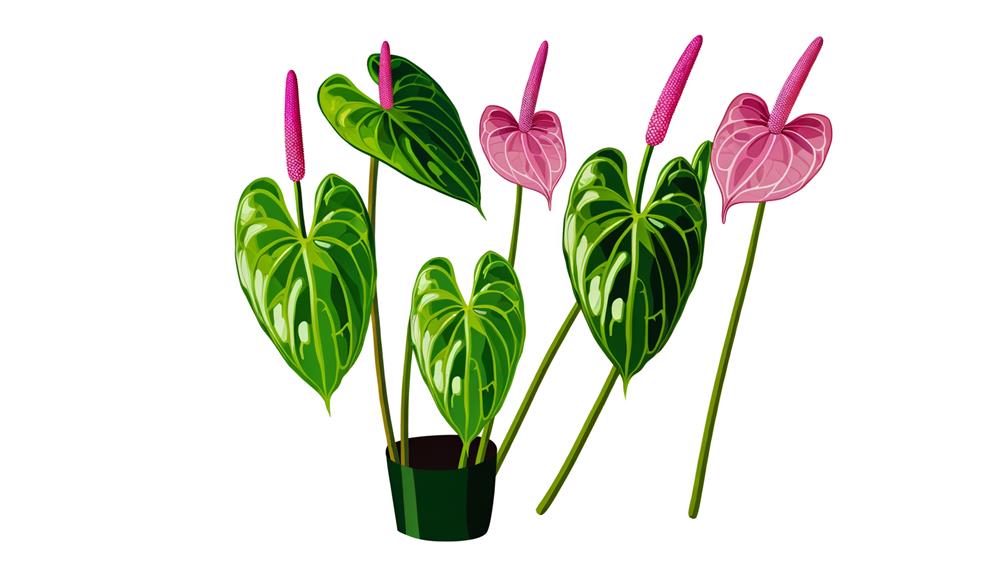
When you provide the ideal indoor environment, you’ll notice that Anthurium Canal Queen exhibits a compact growth habit, typically reaching heights of 18-24 inches with a spread of about 12 inches.
This manageable size makes it perfect for indoor cultivation, maintaining its ornamental appeal without overwhelming your space.
The Anthurium Canal Queen, or *Anthurium andraeanum*, is characterized by its robust, glossy leaves and vibrant spathes, which add a touch of tropical elegance.
Key growth characteristics include:
- Leaf morphology: Broad, heart-shaped leaves with a leathery texture.
- Stem structure: Thick, erect stems that support the plant’s compact form.
- Root system: Aerial roots that enhance nutrient absorption and stability.
Propagation Methods
You’ll find that propagating *Anthurium andraeanum* ‘Canal Queen’ can be efficiently achieved through methods such as stem cuttings, division, and seed germination.
Begin by selecting a healthy stem with at least one node when using stem cuttings. Use a sterile cutting tool to prevent infections.
For division, gently separate the root ball, making sure each section has sufficient roots and foliage. This method is ideal for mature plants.
Seed germination requires patience; sow seeds in a well-draining medium, maintaining consistent moisture and warm temperatures.
Each method allows you to multiply your *Anthurium* while promoting genetic diversity and plant health. Your choice depends on your desired propagation speed and plant maturity.
Common Pests and Solutions
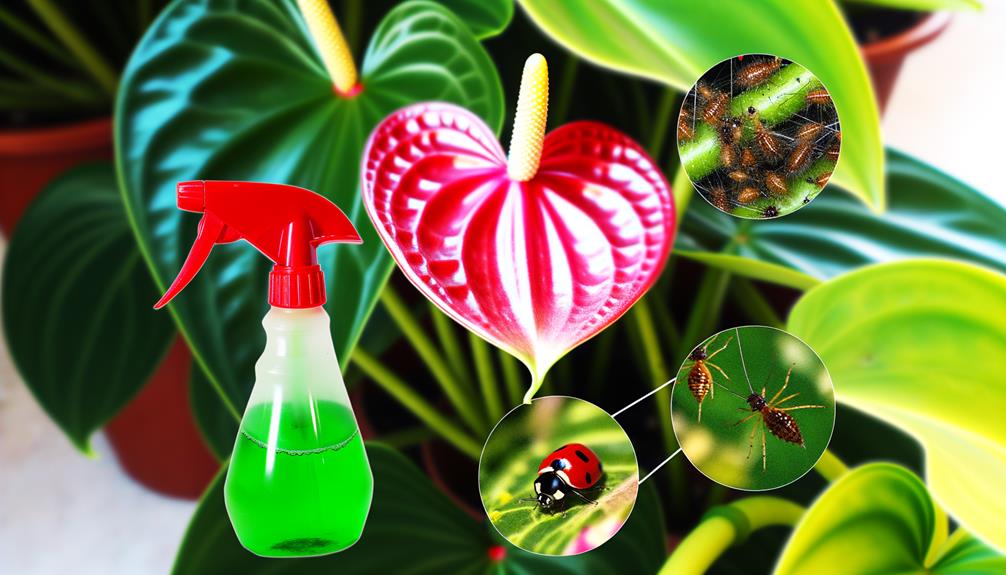
Dealing with common pests like *aphids*, *spider mites*, and *mealybugs* on your *Anthurium andraeanum* ‘Canal Queen’ requires a keen eye and prompt action. These pests can cause significant damage to your plant’s foliage and overall health.
To manage these intruders effectively:
- Insecticidal Soap: Use potassium salts of fatty acids to dissolve the pest’s outer coating, causing dehydration.
- Neem Oil: Apply this natural pesticide to disrupt the pests’ hormonal balance, leading to their eventual death.
- Isopropyl Alcohol: Dab 70% isopropyl alcohol directly onto *mealybugs* to dissolve their protective wax coating.
Regular inspection and immediate treatment will safeguard your Canal Queen thrives, free from these destructive pests.
Don’t let them compromise your plant’s essentiality and beauty.
Conclusion
In conclusion, the Anthurium ‘Canal Queen’ provides a distinctive combination of substantial, shiny leaves and vivid, enduring blossoms that can illuminate any indoor area.
Picture a greenhouse where Anthurium ‘Canal Queen’ flourishes, its unique flower spathes and colorful variations creating a remarkable visual effect.
With its specific growth pattern, size, and simplicity of reproduction, this plant is both a botanical wonder and a visual pleasure, making it essential for plant enthusiasts.

